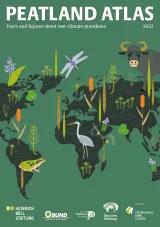
Peatlands all over the world sustain a rich range of habitats and species, including a wide range of threatened and endemic ones. Policymakers are called upon to protect these unique landscapes.

Peatlands are one of a wide range of varied landscapes on our planet, along with forests, grasslands, lakes, marshes, mangroves and other wetlands, all of which contribute to global landscape diversity. Under different conditions, peatlands may be flat, raised or bowl-like. They may have ribbed, polygonal or mounded patterns on the surface, as in the Arctic tundra or the taiga, or be smooth, as along the coast. They may get water from the atmosphere, groundwater, river floods, permafrost or surface flow. They may be covered with trees or reeds – as in the tropics – or mosses, sedges and dwarf trees, as in the taiga.
The surface of a peatland often looks like a piece of art. In the Arctic, where permafrost sculpts the landscape, polygon patterns like ice crystals form on the peatland surface. In the temperate zone, water running from a peat dome creates ridges and hollows. In tropical peatlands, lace-like patterns reflect the former banks of rivers and lakes. All this fascinating diversity of patterns visible from above perform a crucial role in biodiversity: they create a great diversity of habitats within relatively uniform ecological conditions. All habitats in peatlands are densely occupied due to the diversity between and within species of organisms. It has taken thousands of years of evolution to create such highly specialized living communities. Some species have adapted so closely to the extreme conditions of peatlands that they are unable to live in any other habitat. For plants in the temperate zone of Eurasia, there are no more than 15 species that grow exclusively in peatlands: they include the round-leaved sundew or pod grass. In Southeast Asia, some 45 species are recognized as restricted to peat swamp forests, for example, the tropical tree Meranti Bakau, and the woody liana Akar Jitan. In North America, the wood frog is the only species that can successfully reproduce in highly acidic bog waters and can survive deep freezing. The pitcher plant mosquito lays its eggs in the water at the bottom of the pitcher, the larvae is unaffected by the digestive enzymes of the plant – and even providing bacteria to the host plants to help them digest the exoskeletons of other insects that have fallen into the pitcher. Butterfly larvae are tied to plant species at the hormone level: larvae of the ocellate bog fritillary feed on the cranberry only, Cranberry blue lays eggs on blueberry.
There are many other examples of how peatland specialists can survive in challenging environmental conditions. Peatland plants build a microcosm for specific birds, small and large mammals, insects, soil invertebrates, fungi and bacteria. The specialists and their microcosm cannot survive the loss of their habitats when peatlands are drained and changed to other landscapes. If one species disappears, all other organisms that are dependent on it through symbiosis, food, shelter or behaviour also disappear. Peatlands also have less-equipped species as visitors – neighbours, nomads or refugees. Species that live in the neighbourhood pay short visits to peatlands during droughts or in the berry season, for nesting or mating, or in search of a wintering ground. Migrating species come to peatlands only to stop over, feed and rest. They usually stop at exactly the same peatland each year, as their ancestors have done for hundreds or even thousands of years. For example: Cranes stop in the German Teufelsmoor on their way to the South, Swedish swifts winter in the Congo Basin. These species lose their landmarks and crucial resting grounds if important peatlands are drained and disappear. Finally, in times of rapid and dramatic loss of other habitats, peatlands are a refuge for species from other landscapes, such as grasslands or forests. Invasive species brought from peatlands in other continents are able to spread in suitable locations. Examples are the insectivorous purple and yellow pitcher plants. These were brought to Europe from North America as ornamentals, and have successfully populated raised bogs in the Alps and the British Isles during the last 20 years, bringing a serious imbalance into these ecosystems.
But why do we need this landscape, geographical, habitat, species and intraspecies diversity in peatlands? Peatland landscapes have a significant function in maintaining sustainable and resilient socio-ecological systems. The peatlands themselves are built up by the biota that they host. Due to their special features, only the organisms living in peatland can build up peat. Wet peat stores large amounts of carbon and water. That both helps to mitigate climate crisis and provides resilience to landscapes while climate crisis is resulting in much more extreme weather events. Peatland biodiversity not only maintains itself but also sustains very valuable ecosystem services for humanity. The Convention on Biological Diversity and the Kunming-Montreal Global Biodiversity Framework of 2022 call for all countries to protect biodiversity. At least 12 percent of global peatlands are already destroyed. The profits from the use of drained peatlands do not benefit communities that have lost their ecosystem services. We need clean water, settlements near rivers that are protected from flooding, moderated climate conditions, and productive fields and forests. That is why there is need to give strong consideration to biodiversity when restoring and using peatlands.

